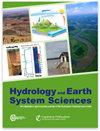关于在地表模型中表示依赖地下水的湿地系统的最佳复杂程度
IF 5.8
1区 地球科学
Q1 GEOSCIENCES, MULTIDISCIPLINARY
引用次数: 0
摘要
摘要湿地系统是地球上最大的碳储存库之一,是所有生态系统中生物多样性最丰富的系统,也是水文循环的主要控制区。然而,它们在陆地表面模式(LSM)中的代表性有限,而陆地表面模式是地球系统模式(ESM)的陆地下边界,为气候行动提供信息。在此,我们探索了不同的参数化方法,以表现湿地-地下水-陆地之间的相互作用,并对系统和计算复杂性进行了不同程度的调整。我们在北美洲北方地区萨斯喀彻温省的白鸥溪(White Gull Creek)进行了一系列数值实验,这些实验参考了一种特殊类型湿地(称为沼泽)的实地观测结果。在本研究中,我们将重点关注修改高地和湿地之间的建模连接对系统结果的影响。我们证明,在土地管理模型中,对依赖地下水的湿地的典型表述会忽略与地下水和高地之间的相互作用,这种表述可能是不充分的。我们表明,模型复杂度的最佳水平取决于土地覆被、土壤类型以及最终建模目的(预测和预报、情景分析或诊断学习)。本文章由计算机程序翻译,如有差异,请以英文原文为准。
On the optimal level of complexity for the representation of groundwater-dependent wetland systems in land surface models
Abstract. Wetland systems are among the largest stores of carbon on the planet, the most biologically diverse of all ecosystems, and dominant controls on the hydrologic cycle. However, their representation in land surface models (LSMs), which are the terrestrial lower boundary of Earth system models (ESMs) that inform climate actions, is limited. Here, we explore different possible parameterizations to represent wetland–groundwater–upland interactions with varying levels of system and computational complexity. We perform a series of numerical experiments informed by field observations from a particular type of wetland, called a fen, at the well-instrumented White Gull Creek in Saskatchewan, in the boreal region of North America. In this study, we focus on how modifying the modelling connection between the upland and the wetland affects the system's outcome. We demonstrate that the typical representation of groundwater-dependent wetlands in LSMs, which ignores interactions with groundwater and uplands, can be inadequate. We show that the optimal level of model complexity depends on the land cover, soil type, and the ultimate modelling purpose, being nowcasting and prediction, scenario analysis, or diagnostic learning.
求助全文
通过发布文献求助,成功后即可免费获取论文全文。
去求助
来源期刊

Hydrology and Earth System Sciences
地学-地球科学综合
CiteScore
10.10
自引率
7.90%
发文量
273
审稿时长
15 months
期刊介绍:
Hydrology and Earth System Sciences (HESS) is a not-for-profit international two-stage open-access journal for the publication of original research in hydrology. HESS encourages and supports fundamental and applied research that advances the understanding of hydrological systems, their role in providing water for ecosystems and society, and the role of the water cycle in the functioning of the Earth system. A multi-disciplinary approach is encouraged that broadens the hydrological perspective and the advancement of hydrological science through integration with other cognate sciences and cross-fertilization across disciplinary boundaries.
 求助内容:
求助内容: 应助结果提醒方式:
应助结果提醒方式:


